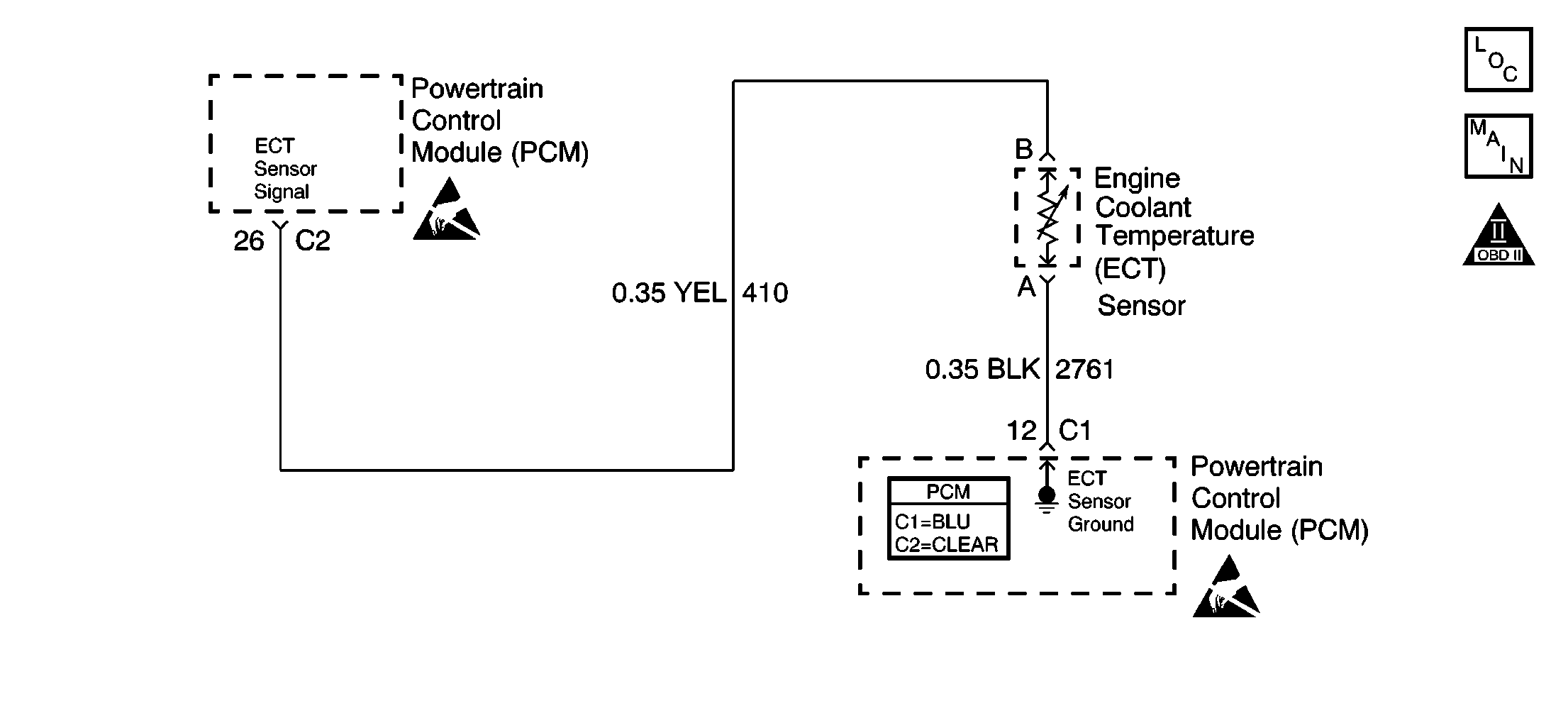
System Description
The purpose of the cooling system is to maintain an efficient engine coolant temperature level during all engine operating conditions. This is accomplished by using a thermostat to regulate the flow of coolant from the engine to the radiator. The thermostat also allows the engine to warm up faster by not allowing coolant flow through the radiator until the engine has reached its operating temperature. An engine coolant temperature (ECT) sensor monitors the temperature of the coolant. This input is used by the powertrain control module (PCM) for engine control and as an enabling criteria for various diagnostics.
The PCM monitors total accumulated air flow to determine if the engine run time is sufficient to reach engine operating temperature. If the coolant temperature does not increase normally or does not reach the regulating temperature of the thermostat, diagnostics that use engine coolant temperature as enabling criteria, may not run when expected.
If engine coolant fails to reach a pre-set target temperature before a calculated air flow is accumulated DTC P0128 will set.
Conditions for Running the DTC
| • | No MAF, IAT, ECT, or VSS DTCs present. |
| • | Coolant temperature is more than -40°C (-40°F). |
| • | Air temperature is more than -7°C (20°F). |
| • | Engine running for more than 4 minutes. |
| • | VSS average more than 15 MPH over the key cycle. |
| • | Mass air flow average reading more than 23 gm/s. |
| • | Vehicle driven more than 3 miles. |
Conditions for Setting the DTC
The length of time for the engine coolant to reach a pre-set temperature is more than it should be.
Action Taken When the DTC Sets
| • | The PCM will illuminate the malfunction indicator lamp (MIL) during the second consecutive trip in which the diagnostic test has been run and failed. |
| • | The PCM will store conditions which were present when the DTC set as Freeze Frame/Failure Records data. |
Conditions for Clearing the MIL/DTC
| • | The PCM will turn OFF the malfunction indicator lamp (MIL) during the third consecutive trip in which the diagnostic has run and passed. |
| • | The history DTC will clear after 40 consecutive warm-up cycles have occurred without a malfunction. |
| • | The DTC can be cleared by using a scan tool. |
Diagnostic Aids
DTC P0128 will set if the diagnostic does not pass within 25 minutes after start-up. If DTC P0128 does not reset, inspect the following items:
| • | Cooling system -- Coolant level. |
| • | Thermostat operation -- Refer to Thermostat Diagnosis in Engine Cooling. |
| • | Cooling fans operation -- Refer to Electric Cooling Fan Diagnosis . |
| • | Inspect for high resistance in wiring related to the ECT sensor. Also, inspect for poor connections at the ECT sensor and PCM. Refer to Testing for Intermittent Conditions and Poor Connections in Wiring Systems for a poor connection at the PCM. |
Many situations may lead to an intermittent condition. Perform each inspection or test as directed.
Important: : Remove any debris from the connector surfaces before servicing a component. Inspect the connector gaskets when diagnosing or replacing a component. Ensure that the gaskets are installed correctly. The gaskets prevent contaminate intrusion.
| • | Loose terminal connection |
| - | Use a corresponding mating terminal to test for proper tension. Refer to Testing for Intermittent Conditions and Poor Connections , and to Connector Repairs in Wiring Systems for diagnosis and repair. |
| - | Inspect the harness connectors for backed out terminals, improper mating, broken locks, improperly formed or damaged terminals, and faulty terminal to wire connection. Refer to Testing for Intermittent Conditions and Poor Connections , and to Connector Repairs in Wiring Systems for diagnosis and repair. |
| • | Damaged harness--Inspect the wiring harness for damage. If the harness inspection does not reveal a problem, observe the display on the scan tool while moving connectors and wiring harnesses related to the sensor. A change in the scan tool display may indicate the location of the fault. Refer to Wiring Repairs in Wiring Systems for diagnosis and repair. |
| • | Inspect the powertrain control module (PCM) and the engine grounds for clean and secure connections. Refer to Wiring Repairs in Wiring Systems for diagnosis and repair. |
If the condition is determined to be intermittent, reviewing the Snapshot or Freeze Frame/Failure Records may be useful in determining when the DTC or condition was identified.
Test Description
The numbers below refer to the step numbers on the diagnostic table.
Step | Action | Values | Yes | No |
|---|---|---|---|---|
1 | Did you perform the Powertrain On Board Diagnostic (OBD) System Check? | -- | ||
2 |
Important: If any other DTCs are set, perform those DTC diagnostics first. With a scan tool, observe if DTC P0128 was set this ignition. Is DTC P0128 set this ignition? | -- | ||
3 |
Important: In order to provide the best opportunity for the DTC to reset, operate the vehicle with the heater on MAX and the heater fan on HIGH. Does the scan tool indicate that DTC P0128 set this ignition? | -- | Go to Diagnostic Aids | |
Is the observed temperature within 5 percent of the predicted temperature? | -- | Go to Engine Fails To Reach Normal Operating Temperature in Engine Cooling | ||
5 | Replace the ECT sensor. Refer to Engine Coolant Temperature Sensor Replacement . Is the action complete? | -- | -- | |
6 |
Does the DTC reset? | -- | System OK |
